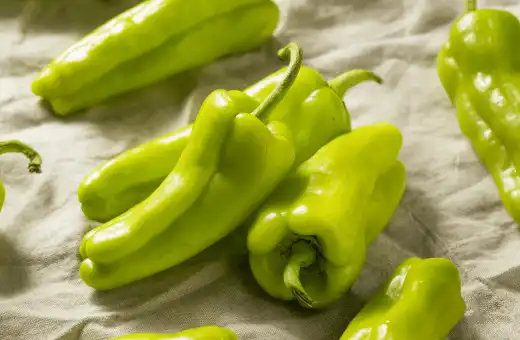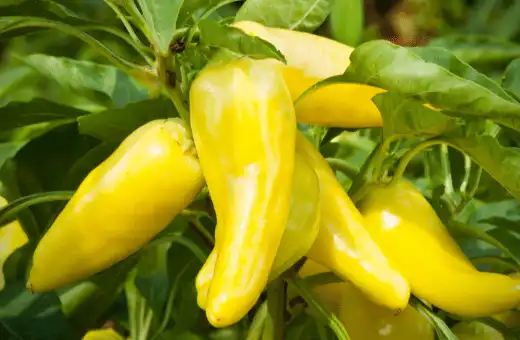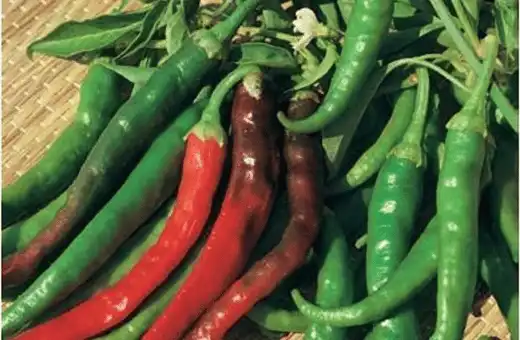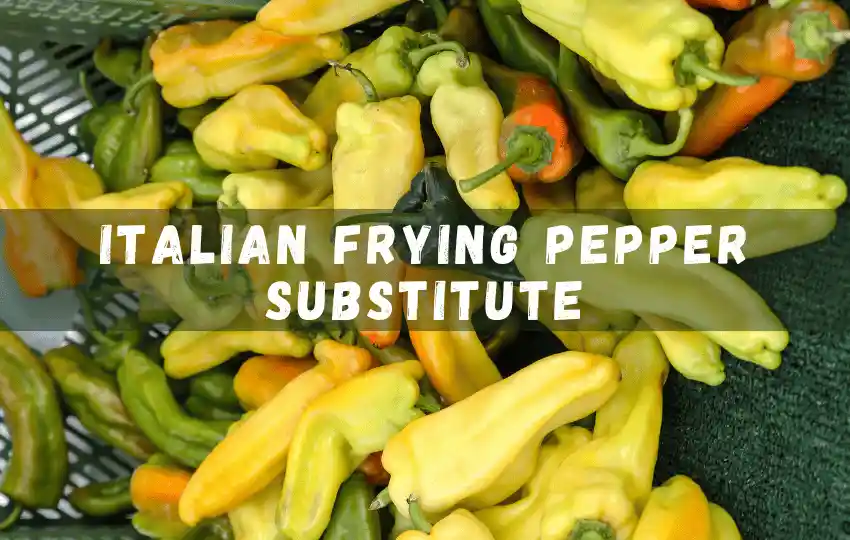Italian frying peppers, also known as Cubanelle peppers, are mild and sweet peppers that are used in many Italian dishes.
There are days when you’re all set to cook an Italian dish, but you forget to add frying peppers to your shopping cart.
It can be disheartening, but don’t lose hope.
There are various Italian Frying Pepper Substitutes to use, and this post will provide you with seven of the best options.
Using the correct substitute is essential, and knowing the ratio measurements can be a time-saver.
As an experienced home cook or chef, this post will give you the best alternatives for frying peppers and help you maintain the Italian taste you aim for in your dishes.
In short, " What can I use instead of Italian frying pepper?" Cubanelle Pepper, Anaheim Pepper, Banana Pepper, Poblano Pepper, Shishito Pepper, Red Bell Pepper, Piment des Landes, Bell Peppers, Gypsy Peppers.
What is Italian frying pepper, and what does Italian frying pepper taste like?
Italian Frying Pepper is a variety of chile peppers that are native to Southern Italy. These long, thin-walled, mild chiles have a slightly sweet flavor with hints of nutmeg and licorice.
They range from yellow-green to red in color and tend to be about 4-5 inches long when mature.
Their mild flavor makes them an ideal pepper for adding heat without overwhelming the other flavors in the dish.
Uses of Italian frying pepper
Italian frying peppers, or ‘friggitelli’, are a popular variety of Italian pepper that boasts a mild flavor with sweet undertones, making it an ideal ingredient for numerous dishes.
Its versatility and subtle, pleasant taste make it an excellent addition to recipes ranging from roasted vegetables to sauces and stews.
In Southern Italy, these peppers are often used to make a traditional dish called ‘peperonata’, which involves sautéing the peppers with onions and herbs in olive oil.
The high water content of Italian frying peppers makes them ideal for pickling.
When preserved in vinegar or oil, the peppers remain crisp and retain much of their original flavor.
Pickled Italian frying peppers can be served as a side dish or appetizer alongside cured meats and cheeses or used in salads as a vibrant garnish.
This type of pepper is also popularly grilled over open flames – either on its own or topped with cheese and herbs.
The result is slightly smoky and wonderfully fragrant, perfect for sandwiches, tacos, pizzas, or simply enjoyed as a light snack with crusty bread.
Italian frying peppers have many uses in the kitchen beyond those mentioned here – they can be stuffed with rice and herbs, blended into pesto-style sauces or pureed into soups.
It’s no surprise that this tasty pepper has remained popular amongst cooks around the world for centuries!
Where to buy Italian frying pepper?
If you are looking for where to buy Italian frying pepper, there are a few different places you can go. Many specialty food stores carry it, as do some international grocery stores.
You can also order online from many retailers that provide a variety of diverse flavors and types of Italian frying pepper.
Best Italian frying pepper substitutes
1. Cubanelle Pepper – A good Italian frying pepper substitute

Cubanelle pepper is a mild, sweet pepper that’s frequently used in Mediterranean dishes.
It has a subtle crunch and thick flesh that holds up well when cooked. Cubanelle pepper can be a great substitute for Italian frying pepper.
Ratio or measurement: The ratio for cubanelle pepper is one large cubanelle pepper for every two Italian frying peppers.
2. Anaheim Pepper – similar taste to Italian frying pepper
Anaheim pepper is a mildly spicy pepper that’s commonly used in Mexican dishes. It has a firm flesh that’s perfect for frying, and when cooked, it’s mild and sweet.
Using Anaheim pepper as a substitute for Italian frying peppers presents your dish with a different flavor, but it’s a worthy taste.
Ratio or measurement: The ratio for Anaheim pepper is one large Anaheim pepper for every two Italian frying peppers.
3. Try Banana Pepper in place of Italian frying pepper

Banana pepper is a sweet, mild pepper that is often used in sandwiches and salads. It’s crispy and crunchy, making it a great substitute for Italian frying peppers.
It may not have the same flavor as Italian frying peppers, but it will do the job.
Ratio or measurement: The ratio for banana pepper is one large banana pepper for every two Italian frying peppers.
4. Poblano Pepper – similar taste to Italian frying pepper
The poblano pepper is a medium-spicy pepper that’s most commonly used in Mexican cuisine. It’s perfect for roasting, stuffing, and, most importantly, frying.
If you’re looking for an alternative flavor to Italian frying peppers, you can use poblano pepper.
Ratio or measurement: The ratio for poblano pepper is one large poblano pepper for every two Italian frying peppers.
5. Shishito Pepper – a great Italian frying pepper alternative

Shishito pepper is a popular Japanese pepper that’s green most times, but it can turn reddish-brown when mature.
It has a thin layer and is perfect for frying. Gaining popularity in Italian cuisine, the Shishito pepper is a viable substitute option for frying peppers.
Ratio or measurement: The ratio for shishito pepper is one small shishito pepper for every Italian frying pepper.
6. Red Bell Pepper – similar taste to Italian frying pepper
Red bell pepper is a sweet pepper with thick and crunchy flesh, which is perfect for frying.
It won’t give you the same taste as Italian frying peppers but is perfect for healthy alternatives.
Ratio or measurement: The ratio for red bell pepper is one large red bell pepper for every two Italian frying peppers.
7. Use Piment des Landes instead of Italian frying pepper

Piment des Landes is a French heirloom pepper that is long and slender, usually bright yellow or red. It’s sweet and mild and excellent for frying or cooking.
Highly sought after, the Piment Des Landes is a luxurious substitute that brings a new world of flavor to your Italian dish.
Ratio or measurement: The ratio for Piment des Landes is one large Piment des Landes pepper for every two Italian frying peppers.
8. Bell Peppers – similar taste to Italian frying pepper
Bell peppers are sweeter and milder than Italian frying peppers, but they can still be used as a substitute in dishes that require frying.
They come in various colors, so you can choose the color that best suits your dish.
Ratio or measurement: Use 1 Bell pepper for every 2 Italian frying peppers.
9. Gypsy Peppers – a decent Italian frying pepper replacement

Gypsy peppers are a bit spicier and sweeter than Italian frying peppers, but they make a great substitute in dishes that require frying. They are also great for stuffing.
Ratio or measurement: Use 1 Gypsy pepper for every 2 Italian frying peppers.
Discover more: Easy Substitutes for Smoky Red Pepper Crema
Tips on How to Choose the Most Suitable Substitution Option for Italian frying pepper
When choosing a substitution option for Italian frying peppers, consider the following tips:
1. Flavor profile: Italian frying peppers have a mild and slightly sweet flavor. Look for substitutes that have a similar taste profile, such as sweet bell peppers or Anaheim peppers.
2. Heat level: Italian frying peppers are typically mild and low in heat. If you prefer a substitute with a similar heat level, opt for sweet bell peppers.
If you prefer more heat, consider using poblano peppers or cubanelle peppers.
3. Texture: Italian frying peppers have a thin skin and a tender texture. Choose a substitute that has a similar texture to maintain the desired cooking and eating experience.
Sweet bell peppers and cubanelle peppers are good options in terms of texture.
4. Size and shape: Italian frying peppers are usually long and slender, but their size can vary.
Consider the size and shape of the peppers you’re substituting to ensure they can be used in a similar way in your recipe.
5. Cooking method: Consider how you plan to cook the peppers. If you’re sautéing or stir-frying them, any suitable substitute mentioned above can work well.
If you’re planning to roast or grill the peppers, consider using sweet bell peppers or poblanos, as they hold up well to these cooking methods.
6. Availability: Check the availability of substitute peppers in your local stores or markets to ensure you can easily find them.
Different regions may have variations in pepper availability, so choose a substitute that is readily accessible to you.
7. Personal preference: Ultimately, choose a substitution option that aligns with your personal taste preferences and the flavors you want to achieve in your dish.
Experiment with different peppers to find the one that suits your needs and enhances your recipe.
Conclusion on Italian frying pepper substitute
There are 9 substitutes for Italian frying peppers for those looking for a different flavor or have no choice in the matter but to explore their options.
With the correct measurement ratios, these substitutes will be up to the task, and your dish will be as Italian as it can be.
Remember, using these substitutes may make your meal unique and unexpectedly delicious, with new flavorful options to explore.
FAQs on Italian frying pepper substitute
Q1. What is similar to Italian frying pepper?
Other varieties of frying peppers similar to Italian frying pepper include banana peppers, Cubanelle peppers, and poblano peppers.
All of these varieties are milder in heat than traditional chili or bell peppers and have a sweet flavor when cooked. They can be used for sautéing, baking, stuffing, roasting, or even eaten raw as part of salads.
Q2. Are cubanelle peppers the same as Italian frying peppers?
No, cubanelle peppers are not the same as Italian frying peppers. Cubanelle peppers are known for their mild and sweet flavor, while Italian frying peppers have a slightly more bitter taste.
Cubanelles are usually longer and thinner than Italian frying peppers, with a light green color that turns red when ripe. In contrast, Italian frying peppers are rounder in shape and have a bright yellow or orange hue when ripe.
Cubanelles are used primarily in Caribbean cuisine, while Italian frying peppers are more commonly found in Mediterranean recipes, such as pasta sauces and frittatas.
Cubanelle peppers can be cooked in much the same way as Italian frying peppers, but they may require less time to soften and become sweeter if left on the stovetop for longer.
Q3. What kind of peppers do Italians cook with?
Italians often use a variety of peppers when cooking, such as bell peppers, cherry peppers, and hot peppers like jalapeños and red pepper flakes.
Bell peppers are commonly used in Italian dishes like pizza or pasta sauces, while the spicier cherry and jalapeño peppers are frequently included in traditional Italian recipes like arrabbiata sauce.
Red pepper flakes add heat to many classic dishes like spaghetti with garlic and olive oil.
Additionally, many Italian cooks will use dried hot chili peppers to make their own spice blends for marinades and rubs.
Q4. What spice level is Italian frying pepper?
Italian frying peppers, also known as Italian peppadews, are a sweet and mild pepper variety.
They offer a low to medium heat level on the Scoville scale (between 100-1000 SHU), making them an ideal option for those who prefer milder spice levels in their dishes.
The flavor profile of these peppers is sweet with hints of citrus and smokiness.
They’re often used in salads, pasta, pizzas, sandwiches, salsas, and more. Peppadews can withstand higher temperatures than many fresh peppers and therefore make a great option for frying or roasting.
These peppers add a unique flavor element to dishes that can be enjoyed by everyone with their versatility and low spice level.
Q5. Does frying peppers make them hotter?
No, frying peppers does not make them hotter. While the pepper’s pungency can intensify through lengthy exposure to heat, most of the capsaicin in the pepper remains intact.
Therefore, peppers may taste spicier when cooked due to an enhanced flavor, but their pungency is not increased or decreased by cooking.

